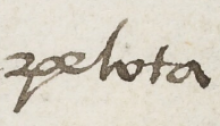ollamaloni (Mdz70r)
This example of iconography shows what the gloss calls a "pelota" (Spanish for ball), and what we are calling an ollamaloni (a black rubber ball, in Nahuatl). We could name it olli, too, because it is much like some glyphs or glyphic elements for the term olli (rubber or rubber ball). The ball here is a circle filled in with black ink or paint.
Stephanie Wood
The contextualizing image shows a ball player with his arms aloft and the ball in the air just off his hip. This is probably not a coincidental location, given that many sources mention how the ball could be hit with the hip. The ball player is male, as he wears a loin cloth.
Glyphs for olli will sometimes be simple round black-filled circles (e.g., Codex Mendoza folio 20 recto and 37 recto), and sometimes they will have a white boundary around the black circle (e.g., Codex Mendoza folio 13 recto, 16 recto, and 36 recto).
Stephanie Wood
pelota
Stephanie Wood
c. 1541, by 1553 at the latest
pelotas, hule
ollamaloni, a rubber ball, https://nahuatl.wired-humanities.org/content/ollamaloni
ol(li), rubber, https://nahuatl.wired-humanities.org/content/olli
la pelota de hule
Stephanie Wood
Codex Mendoza, folio 70 recto, https://digital.bodleian.ox.ac.uk/objects/2fea788e-2aa2-4f08-b6d9-648c00..., image 150 of 188.
Original manuscript is held by the Bodleian Libraries, University of Oxford, MS. Arch. Selden. A. 1; used here with the UK Creative Commons, “Attribution-NonCommercial-ShareAlike 3.0 License” (CC-BY-NC-SA 3.0)


